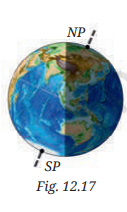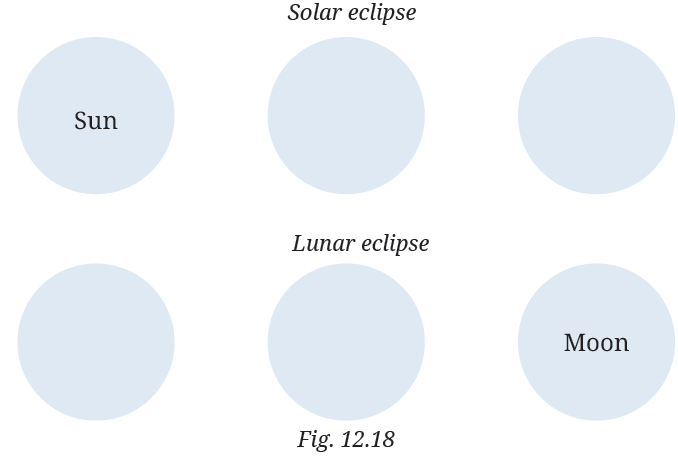Solutions For All Chapters – Science Curiosity Class 7
Earth, Moon, and the Sun
1. In Fig. 12.17, how many hours of sunlight do the North Pole and the South Pole receive during one rotation of the Earth?
Answer: In Fig. 12.17, the North Pole receives 24 hours of sunlight during one rotation of the Earth in June, as it is continuously in sunlight. The South Pole receives 0 hours of sunlight, as it is in complete darkness during this time.
2. Fill in the blanks
(i) Stars rise in the East and set in the West.
(ii) Day and night are caused by the Earth’s rotation.
(iii) When the Moon fully covers the Sun from our view, it is called a total solar eclipse.
3. State whether True or False
(i) Lunar eclipse occurs when the Sun comes between the Earth and the Moon.
Answer: False.
(ii) Sunrise happens earlier in Gujarat than in Jharkhand.
Answer: False.
(iii) In Chennai, the longest day occurs on the summer solstice.
Answer: True.
(iv) We should watch the solar eclipse directly with our naked eye.
Answer: False.
(v) Seasons occur due to the tilt of Earth’s axis of rotation and its spherical shape.
Answer: True.
(vi) The Earth’s revolution around the Sun causes day and night.
Answer: False.
4. Padmashree saw the Orion constellation nearly overhead at 8 pm yesterday. When will she see Orion overhead today?
Answer: Padmashree will see the Orion constellation nearly overhead at around 7:56 pm today. Due to the Earth’s rotation, stars appear to rise about 4 minutes earlier each day (since the Earth’s rotation period is approximately 23 hours 56 minutes, not exactly 24 hours). Thus, Orion will be overhead approximately 4 minutes earlier than the previous day.
5. Nandhini saw a group of stars rising at midnight on 21 June. When will she see the same group of stars rising at midnight next year?
Answer: Nandhini will see the same group of stars rising at midnight on 21 June next year. The Earth’s revolution around the Sun takes about 365 days, so the night sky’s appearance repeats annually. The same group of stars will rise at midnight on the same date (21 June) the following year.
6. Abhay noticed that when it was daytime in India, his uncle who was in the USA was generally sleeping as it was night-time there. What is the reason behind this difference?
Answer: The reason is the Earth’s rotation. India and the USA are in different time zones because they are located on opposite sides of the Earth. When the Earth rotates, the side facing the Sun (like India during daytime) experiences day, while the opposite side (like the USA at that time) is in darkness, experiencing night. This causes the time difference.
7. Four friends used the following ways to see the solar eclipse. Who among them was being careless?
(i) Ravikiran used a solar eclipse goggle.
(ii) Jyothi used a mirror to project the Sun’s image.
(iii) Adithya saw the Sun directly with his eyes.
(iv) Aruna attended a programme arranged by a planetarium.
Answer: Adithya was being careless. Viewing a solar eclipse directly with the naked eye (as Adithya did) can damage the eyes and cause blindness. The other methods-using solar eclipse goggles (Ravikiran), projecting the Sun’s image with a mirror (Jyothi), and attending a planetarium programme with proper equipment (Aruna)-are safe ways to observe a solar eclipse.
8. Fill in the circles in Fig. 12.18 appropriately with one of the following: Sun, Moon, Earth.
Answer:
For Solar eclipse: The order is Sun, Moon, Earth. (The Moon comes between the Sun and the Earth, blocking sunlight.)
For Lunar eclipse: The order is Sun, Earth, Moon. (The Earth comes between the Sun and the Moon, blocking sunlight from reaching the Moon.)
9. The Moon is much smaller than the Sun, yet it can block the Sun completely from our view during a total solar eclipse. Why is it possible?
Answer: The Moon can block the Sun completely during a total solar eclipse because the apparent sizes of the Moon and the Sun are similar when viewed from Earth. Although the Sun is much larger, it is also much farther away. The Moon, being much closer to Earth, appears almost the same size as the Sun in the sky, allowing it to cover the Sun completely during a total solar eclipse.
10. The Indian cricket team matches in Australia are often held in December. Should they pack winter or summer clothes for their trip?
Answer: The Indian cricket team should pack summer clothes for their trip to Australia in December. In December, the Southern Hemisphere (where Australia is located) is tilted towards the Sun, experiencing summer, while the Northern Hemisphere (including India) experiences winter.
11. Why do you think lunar eclipses can be seen from a large part of the Earth when they happen, but total solar eclipse can be seen by only a small part of the Earth?
Answer: Lunar eclipses can be seen from a large part of the Earth because they occur when the Earth’s shadow falls on the Moon, and anyone on the night side of the Earth (a large area) can see the Moon. In contrast, a total solar eclipse can only be seen from a small part of the Earth because the Moon’s shadow covers only a small area on the Earth’s surface, and only those within that area can witness the total eclipse.
12. If the Earth’s axis were not tilted with respect to the axis of revolution, explain what would be the effect on seasons?
Answer: If the Earth’s axis were not tilted, there would be no seasons as we know them. The tilt of the Earth’s axis causes different parts of the Earth to receive varying amounts of sunlight throughout the year, leading to seasons. Without the tilt, sunlight would be distributed evenly across the Earth year-round, resulting in similar weather conditions all year, with no distinct summer, winter, spring, or autumn.



Leave a Reply